Dominant trans discourses most often stress transgender lives as constantly in danger, policed, in a state of suffering, or discriminated against. An ever-growing amount of research is frequently released on the effects of oppression on transgender people, such as the lack of quality health care and the high rates of mental illness and suicide among the population. More and more often, the countless threats to the well-being of transgender people are “exposed”: laws banning (trans)people from using the bathroom of their choice, societal discrimination, police brutality, and the list goes on. These dialogues that focus on the pain that American transgender people experience dominate the conversation. Although it is crucial in order to acknowledge systematic trans persecution and to fight for better, the idea that transgender lives are defined by suffering neglects the existence and lived experiences of transgender people. Transgender people have jobs, families, friends, passions, and ambitions—realities often not explored or delved into as much as trans discrimination.
Fashion—one such passion project, form of self-expression, and/or element of everyday life for transgender people—encompasses the many intricacies of the trans experience. The freedom to choose what one puts on their body has power in itself and can act as a political statement or form of rebellion against the expectation to dress along the gender binary.
Trans Fashion as Expression
Although one “trans aesthetic” does not exist (and cannot exist due to the overwhelming diversity of expression among trans people), trans fashion as a distinct entity is available to be explored and treasured. Many notable trans people have become renowned based on their conception of trans fashion as fluid and free from the normative constraints of dressing as either a stereotypical feminine woman or masculine man. Hari Nef, the first trans woman to be signed to the highly-esteemed IMG Worldwide (international model management firm), is an icon in the fashion world and trans community.
Her personal style and fashion choices are drawn from her career based on “creating, re-creating, meta-creating” herself. She chooses to dress how she wants—which is rarely static—as she notes to Katherine Bernard of Vogue, “I’m a different girl almost every time I look in the mirror.” Nef’s fame has arisen from her fluctuating, poised, and dynamic style—often characterized as gender neutral.
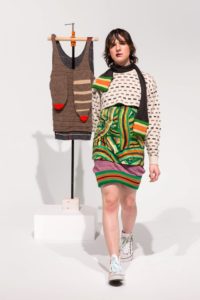
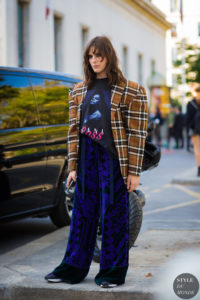
Pictures of Nef (left to right):
http://degen.us/collections/fallwinter15/presentation/#/picture_1
http://www.styledumonde.com/2017/09/paris-ss-2017-street-style-hari-nef-jacquemus-blazer/
Nef’s broad and flexible view of her own womanhood and the way it shapes her personal expression is often difficult for others to understand. As she explains in an interview with Vogue:
“Insisting on perhaps a more gender ambiguous or barefaced or subtle femininity as a trans woman has opened me up to certain dangers and rejection. There’s also confusion from cisgender folks. It’s like, ‘Girl, you should be doing everything you can to be femme. Why aren’t you? If you went a little harder for this, people really wouldn’t clock you! You could really get straight men!’”
Nef’s choice to express herself according to her ever-changing view of her own womanhood receives backlash as her status of “transwoman” societally-implicates overt femininity. Her refusal to dress along the rigidness of this gender binary, while still identifying as a woman, raises the issue of acceptability of trans bodies and how trans people “should” appear/dress based on their identity.
Link to the Vogue article: https://www.vogue.com/article/hari-nef-transgender-model-img-interview
Fashion and one’s personal style can be and should be looked at as an artistic art form or artistic expression. Apparel designed for and designed by trans people innately expands the boundaries of fashion. The experience of trans/ gender nonconforming people in living beyond gender norms in their day to day lives is often translated into their fashion. Confidence and resilience, crucial aspects of the trans (and larger LGBTQ+) experience and frequently necessary for survival, create a base for the “fierceness” that is so desired in today’s style icons. These captivating qualities can be observed in the popularity of ALOK, an entertainer, artist, and activist. ALOK’s unapologetic self-expression and self-assurance has seeped into their “eclectic sense of style” and “internationally renowned” reputation, garnering them attention as a true artistic icon.
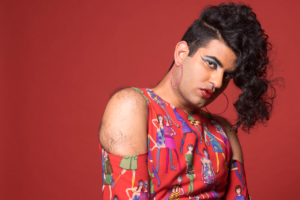
Link to ALOK’s website:
Trans fashion as pop culture can also be observed through social media, blogs, apparel lines, and more—beyond just the influence of trans/gender non-conforming icons. From websites like Pinterest (ex: https://www.pinterest.co.uk/showstudio/tumblr-fashion-the-trans-aesthetic/ ), Tumblr and grassroots clothing designers, trans fashion has a large reach. FLAVNT Streetwear is an independent clothing line that is a “brand by queer people for queer people.” Their mission that simply states: “We don’t believe in men’s or women’s clothing, we just make clothes that promote self-confidence and self-love” is the type of message of love and transcending of gender barriers that is a common thread in the trans fashion industry.
Link to FLAVNT: http://www.flavnt.com/about/
The magazine Candy is another influential trans fashion hub, celebrating “transvestism, transsexuality, crossdressing and androgyny in all their glory.” Dubbed as “The First Transversal Style Magazine”, Candy provides an environment of “fashion, art, culture, make-up, glamour, icons, amazing transformations and fun” through one singular, yet open forum—a way for people to potentially escape their not so free day to day lives.
Link to Candy: http://byluisvenegas.com/candy/candy-2nd-issue/#34&panel1-1
Trans Fashion as Activism
Not only is trans fashion used to showcase individuality and artistic expression, but it is sometimes utilized as a form of informational or political activism. For transgender people to dress in the way they feel reflects their identity, without the pressures to “pass”, is a form of defiance—yet often dangerous for the less privileged. In a more outright way as well, trans designers have begun to incorporate advocacy-centered messages into their lines in order to stand in support of trans people (and the LGBTQ+ community at large). Incorporating these themes into fashion allows wearers of the clothing to make public statements about their acceptance of trans people any time they wear it. Point 5cc is a designing and clothing company that does just this. Their self-given description of “Stealth & Out-and-Proud Trans Apparel for All Genders & Identities” creates attire to suit anyone’s personal style—disregarding normative gender standards for dress. The brand creates clothing such as graphic tees displaying phrases like “Forever Transforming Masculinity” and “Trans Strong” which show pride for the transgender community. Wearing messages like these in public can also be viewed as a type of informational activism, making the public aware of one’s solidarity with the LGBTQ+ community and that trans people live normal lives just like everybody else. The brand’s mixing of normative “women’s apparel” and “men’s apparel” also pushes boundaries and opens up spaces for trans individuals to wear what makes them feel comfortable. An example of this is the brand’s rose-patterned skateboarder hat—a traditionally feminine pattern on a traditionally masculine style of hat.
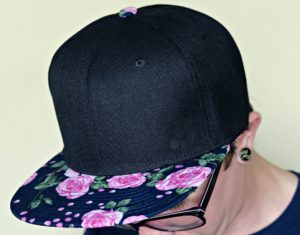
Link to Point 5cc: http://point5cc.com
Trans Fashion Accessibility
As wonderful and necessary as it is that trans fashion is beginning to garner more attention, break down barriers, and stand on a larger and politically-active platform, many American trans people still don’t have access to this freedom or luxury. Because discrimination and violence is such a present and constant reality for transgender individuals, the idea of dressing to one’s own personal preference is not always a choice, as many are pressured to look and act overtly masculine or feminine in order to “pass” as a “true man” or “true woman” to evade being “found out” as trans, and thus targeted for their identity. In these majority cases, wearing a “Proud and Out” t-shirt is not necessarily an option for many trans folks who fear backlash or assault from the dominant heteronormative society. Additionally, living in an accepting environment in which one is able to experiment with fashion and make political statements without fear is not the reality for many trans folks. For these individuals, expressing themselves through norm-shattering trans fashion is not possible—thus limiting their access in a way, to their own self-expression and political activism.
Economically, the disproportionally less well-off transgender American population faces a struggle in being able to afford this trans-specific fashion that they may strongly desire. For the many transgender people that are unable to acquire high-paying jobs due to discrimination, or for those that are struggling money-wise due to pricey transition-relation procedures; high costs can be a barrier when it comes to accessing trans (high) fashion. Some communities are addressing this problem however, by hosting clothing swaps (such as The Tumblr Transgender Clothing Exchange) where people “trade or give away articles of clothing that no longer suit them, but may be perfect for a member of the community struggling to fill out their wardrobe.” (Pacific Standard:
https://psmag.com/social-justice/we-cant-all-afford-gucci)). Although some grassroots organizations are addressing this money problem when it comes to trans fashion and clothing, there is still much more to do to improve access for trans people. Would the next step towards greater accessibility be for top trans brands to offer more affordable high fashion, to fit the American trans population of its focus?
Trans fashion, style, and self-expression are forms of art and activism that require a larger, more prominent platform in the realm of trans studies and in American society at large. Trans expression that pushes boundaries and rebels against normative society is essential to celebrate the real lives and passions of transgender people. The difficulty for many trans individuals to access this apparel and express oneself fully (without fear of persecution) needs to be addressed within the discourses of trans fashion and trans activism. Thus, the question of how to encourage trans freedom of self-expression and advocacy, while considering and attending to the struggles of less privileged transgender individuals, still stands.
By: Hailey Ulrich
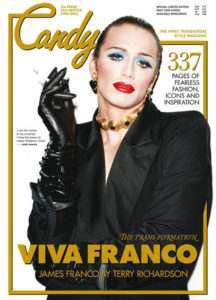
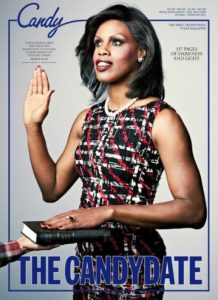
I really liked the idea that was behind your blog post. A person’s fashion is key to their identity by showing off their character traits and is a form of their expression. However, clothing has taken on a more gendered approach with ‘men’ being confined in pants and shirts, while ‘women’ get to wear skirts and dresses. I like the different measures of accessibility that you mentioned, like the clothing exchange. It helps broaden the scope for people who are uncomfortable or unsafe going to a store in person to try on and buy clothes that do not fit their assigned normative gender. I have been reading other blog posts that have talked about trans representation, and I think that it would also be important to have more mainstream representation (or this could already be mainstream, and I just never knew about it) of people wearing clothing that was not solely masculine or feminine. It could help show the spectrum of gender and that people do not need to ‘pass’ as one or the other.
First of all, thank you for all these really great links, I just had a really good time surfing around learning about different trans* models I had never heard of before. I think your blog post was such an interesting topic because as you’ve mentioned, people’s fashion can be such a fundamental form of self-expression for cis and trans* people. One section of your post really stood out to me, “For transgender people to dress in the way they feel reflects their identity, without the pressures to “pass”, is a form of defiance—yet often dangerous for the less privileged.” It really made me think about how fashion can be brushed off as trivial but can truly be both a form of art, a form of activism, and a battleground. It is so inspiring to see people like Hari Nef and ALOK busting down the gender binary with their clothing. In a world with such rigid expectations on what is meant for “men” vs. “women,” trans* individuals are truly helping create a world where everyone can proudly be themselves.
I really enjoyed this post since I do not often read articles on the activist and political role of fashion. I think that fashion absolutely has a place as soft activism, particularly in the context it has publically. Reading this blog post made me think of how fashion can be a way for people who are nervous about involvement in public activism to get involved. Many times, one of the most difficult aspects of getting involved in public activist efforts is the expectation that you then need to defend all of your opinions to those who do not agree with them. This can be an anxiety-producing or nerve-racking aspect of activism that could be slightly negated by using a form of soft activism, such as fashion, to metaphorically dip your toe in activist waters. By wearing shirts that say “patriarchy shmatriarchy” or “gender roles are dead,” such as the shirts sold at flavnt say, it could create a way for more activists to come out of the woodwork and help promote the rights of trans* individuals. Additionally, I was glad that you highlighted the individuals who would not, due to monetary or other reasons, have access to these kinds of fashion and that outfit choice is a form of privilege and the ways that websites such as The Tumblr Transgender Clothing Exchange are looking to combat that.
I really enjoyed this post as well! I hadn’t considered the role that fashion (and fashion publications like Candy) can play in activism until recently. I interviewed some of ROCKET magazine’s leadership for a feature, and all of them spoke about how they viewed fashion as something political, and how the magazine had recently shifted its focus to be more diverse and political. Several of their spreads have since focused on on gender neutral/gender fluid fashion expressions which is really cool at a local level! I also agree that this post’s inclusion of how this is not accessible for all trans people is very important, since I know that activism focusing on clothing and other accessories has long been contested for being out of the financial reach of many. However, I definitely think that fashion exists as a form of activism, and I liked reading more about how specific individuals utilize it!